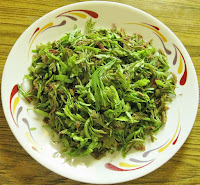Gummadikaya (pumpkin) is a popular vegetable in many countries.
In India all over the country gummadikaya is available. In many areas it is used in festive occasions like weddings and house warming functions. Either a subzi or a pulusu (mixed vegetable sweet and sour stew) cooked with pumpkin is definitely served in festive lunches.
Similarly in North America and Canada pumpkin pie is a traditional part of Thanksgiving meals. From middle of September, one finds many kinds of pumpkins all over USA. Pumpkins have a lot of significance in Halloween folklore.
Pumpkin leaves, flowers and seeds are edible.
Pumpkin has a lot of medicinal value also. Pumpkin is highly nutritious and very rich in vitamin A.
It is contains high amount of antioxidants and may reduce risk of chronic diseases and boost immunity. Pumpkin is high in nutrient density and low in calories. Consuming pumpkin may help in weight loss.
Some people may be allergic to pumpkin. Also, it is mildly diuretic, which means eating a lot of pumpkin may induce production of more urine.
In USA and Canada you find pumpkin pie, pumpkin bread and even pumpkin latte! In India lot of subzis and sweets are made with pumpkin. Here is a recipe for pumpkin halwa. Very little sugar and ghee (clarified butter) are used, so that it is not overly rich!
This festive season, try out this halwa for your holidays!






Ingredients:
Directions:
In India all over the country gummadikaya is available. In many areas it is used in festive occasions like weddings and house warming functions. Either a subzi or a pulusu (mixed vegetable sweet and sour stew) cooked with pumpkin is definitely served in festive lunches.
Similarly in North America and Canada pumpkin pie is a traditional part of Thanksgiving meals. From middle of September, one finds many kinds of pumpkins all over USA. Pumpkins have a lot of significance in Halloween folklore.
Pumpkin leaves, flowers and seeds are edible.
Pumpkin has a lot of medicinal value also. Pumpkin is highly nutritious and very rich in vitamin A.
It is contains high amount of antioxidants and may reduce risk of chronic diseases and boost immunity. Pumpkin is high in nutrient density and low in calories. Consuming pumpkin may help in weight loss.
Some people may be allergic to pumpkin. Also, it is mildly diuretic, which means eating a lot of pumpkin may induce production of more urine.
In USA and Canada you find pumpkin pie, pumpkin bread and even pumpkin latte! In India lot of subzis and sweets are made with pumpkin. Here is a recipe for pumpkin halwa. Very little sugar and ghee (clarified butter) are used, so that it is not overly rich!
This festive season, try out this halwa for your holidays!






Ingredients:
- 3 cups grated pumpkin
- 3/4 cup sugar
- 1 or 2 Tbs, sooji (cream of wheat)
- 2 Tbs. ghee (clarified butter)
- 2 Tbs. cashew nuts
- 1 Tbs. raisins
- 4 or 5 green cardamom
- Wash and cut the pumpkin in half.
- Remove seeds and inside pulp.
- Peel the skin off.
- Either you can grate them or
- Cut in to one inch pieces.
- Process the pieces and a vegetable chopper.
- Grind in a powder grinder or pestle and mortar cardamom seeds.
- Heat a thick pan.
- Add ghee.
- When the ghee melts, add cashews and cook for 2 minutes.
- When cashews are turning brown, add raisins.
- Remove them from the pan and set aside.
- To the same pan, add sooji.
- Keep stirring so that sooji is not burnt.
- After 2 or 3 minutes, add grated/processed pumpkin.
- On low heat cook for 5 to 6 minutes.
- Keep stirring.
- When the moisture is almost evaporated, add sugar.
- After adding sugar, more moisture will be there.
- Keep stirring till the mixture becomes compact and leaves the sides and bottom of the pan.
- When touched, the mixture does not stick to the fingers.
- At this stage, the halwa is ready.
- Add cardamom powder and nuts.
- Mix well.
- Transfer to serving bowl and serve hot.
- Tastes nice whether eaten hot or refrigerated.











































